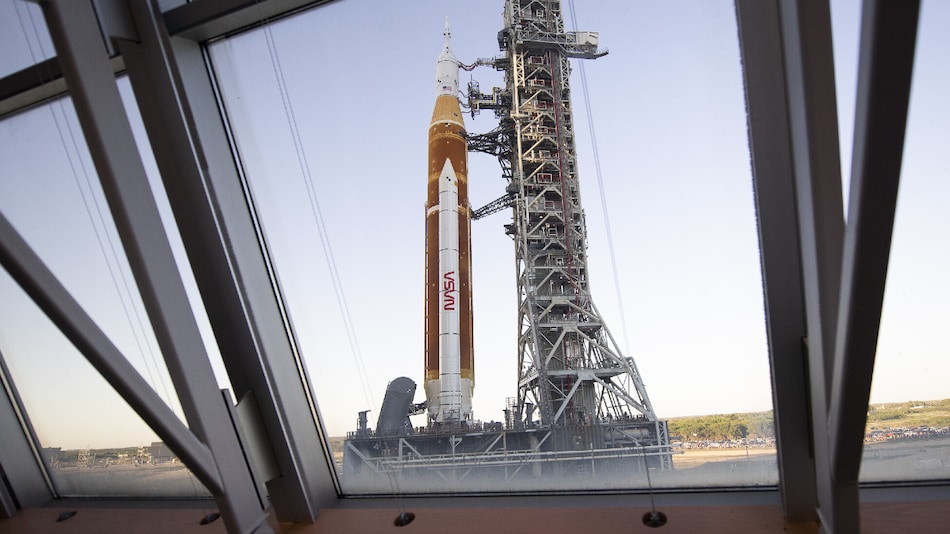- Home
- Science
- Science News
- NASA Rolls Out SLS Moon Rocket: Here’s What You Need to Know About ‘World’s Most Powerful Rocket’
NASA Rolls Out SLS Moon Rocket: Here’s What You Need to Know About ‘World’s Most Powerful Rocket’
The new NASA rocket will be launched to the Moon later this year.

Photo Credit: Twitter/ NASA
SLS team will load over 700,000 gallons (3.2 million litres) of cryogenic propellant into the rocket
NASA's massive new rocket began its first journey to a launchpad on Thursday ahead of a battery of tests that will clear it to blast off to the Moon this summer.
It left the Kennedy Space Center's Vehicle Assembly Building around 5:47pm ET (21:47 GMT) and began an 11-hour journey on a crawler-transporter to the hallowed Launch Complex 39B, four miles (6.5 kilometres) away.
Around 10,000 people had gathered to watch the event.
Huge rocket, huge cost
With the Orion crew capsule fixed on top, the Space Launch System (SLS) Block 1 stands 322 feet (98 meters) high — taller than the Statue of Liberty, but a little smaller than the 363 feet Saturn V rockets that powered the Apollo missions to the Moon.
Despite this, it will produce 8.8 million pounds of maximum thrust (39.1 Meganewtons), 15 percent more than the Saturn V, meaning it's expected to be the world's most powerful rocket at the time it begins operating.
"Ladies and gentlemen, the world's most powerful rocket ever right here!" NASA administrator Bill Nelson told a crowd. "We imagine, we build, we never stop pushing the envelope of what is possible."
A symbol of US space ambition, it also comes with a hefty price tag: $4.1 billion (roughly Rs. 31176.605 crore) per launch for the first four Artemis missions, NASA Inspector General Paul Martin told Congress this month.
After reaching the launchpad, there are roughly two more weeks' worth of checks before what's known as the "wet dress rehearsal."
The SLS team will load more than 700,000 gallons (3.2 million litres) of cryogenic propellant into the rocket and practice every phase of launch countdown, stopping ten seconds before blast off.
To the Moon and beyond
NASA is targeting May as the earliest window for Artemis-1, an uncrewed lunar mission that will be the first integrated flight for SLS and Orion.
SLS will first place Orion into a low Earth orbit, and then, using its upper stage, perform what's called a trans-lunar injection.
This manoeuvre is necessary to send Orion 280,000 miles beyond Earth and 40,000 miles beyond the Moon — further than any spaceship capable of carrying humans has ventured.
On its three-week mission, Orion will deploy 10 shoebox size satellites known as CubeSats to gather information on the deep space environment.
Its "passengers" will include three mannequins collecting radiation data, and a plush Snoopy toy, long a NASA mascot.
It will journey around the far side of the Moon, using thrust provided by the European Space Agency (ESA) thruster, and finally make its way back to Earth, where its heat shield will be tested against the atmosphere.
Splashdown takes place in the Pacific, off the coast of California.
Artemis-2 will be the first crewed test, flying around the Moon but not landing, while Artemis-3, planned for 2025, will see the first woman and first person of colour touch down on the lunar south pole.
NASA wants to build a permanent presence on the Moon, and use it as a proving ground for technologies necessary for a Mars mission, sometime in the 2030s, using a Block 2 evolution of the SLS.
SLS v Starship NASA calls SLS a "super heavy lift exploration class vehicle." The only currently operational super heavy rocket is SpaceX's Falcon Heavy, which is smaller.
Elon Musk's company is also developing its own deep space rocket, the fully reusable Starship, which he has said should be ready for an orbital test this year.
Starship would be both bigger and more powerful than SLS: 394 feet tall with 17 million pounds of thrust. It could also be considerably cheaper.
The tycoon has suggested that within years, the cost per launch could be as little as $10 million (roughly Rs. 76.03 crore).
Direct comparisons are complicated by the fact that while SLS is designed to fly direct to its destinations, SpaceX foresees putting a Starship into orbit, and then refuelling it with another Starship so it can continue its journey, to extend range and payload.
NASA has also contracted a version of Starship as a lunar descent vehicle for Artemis.
Other super heavy rockets under development include Blue Origin's New Glenn, China's Long March 9 and Russia's Yenisei.
Catch the latest from the Consumer Electronics Show on Gadgets 360, at our CES 2026 hub.
Related Stories
- Samsung Galaxy Unpacked 2025
- ChatGPT
- Redmi Note 14 Pro+
- iPhone 16
- Apple Vision Pro
- Oneplus 12
- OnePlus Nord CE 3 Lite 5G
- iPhone 13
- Xiaomi 14 Pro
- Oppo Find N3
- Tecno Spark Go (2023)
- Realme V30
- Best Phones Under 25000
- Samsung Galaxy S24 Series
- Cryptocurrency
- iQoo 12
- Samsung Galaxy S24 Ultra
- Giottus
- Samsung Galaxy Z Flip 5
- Apple 'Scary Fast'
- Housefull 5
- GoPro Hero 12 Black Review
- Invincible Season 2
- JioGlass
- HD Ready TV
- Laptop Under 50000
- Smartwatch Under 10000
- Latest Mobile Phones
- Compare Phones
- Honor Magic 8 RSR Porsche Design
- Honor Magic 8 Pro Air
- Infinix Note Edge
- Lava Blaze Duo 3
- Tecno Spark Go 3
- iQOO Z11 Turbo
- OPPO A6c
- Samsung Galaxy A07 5G
- Lenovo Yoga Slim 7x (2025)
- Lenovo Yoga Slim 7a
- Lenovo Idea Tab Plus
- Realme Pad 3
- Moto Watch
- Garmin Quatix 8 Pro
- Haier H5E Series
- Acerpure Nitro Z Series 100-inch QLED TV
- Asus ROG Ally
- Nintendo Switch Lite
- Haier 1.6 Ton 5 Star Inverter Split AC (HSU19G-MZAID5BN-INV)
- Haier 1.6 Ton 5 Star Inverter Split AC (HSU19G-MZAIM5BN-INV)







![[Sponsored] Haier C90 OLED TV | Dolby Vision IQ, 144Hz OLED and Google TV in Action](https://www.gadgets360.com/static/mobile/images/spacer.png)









